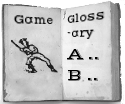Cat i’ The Hole: Difference between revisions
(Set Game Eras to Predecessor) |
No edit summary |
||
| Line 3: | Line 3: | ||
|Game Family=Kickball | |Game Family=Kickball | ||
|Location=Scotland | |Location=Scotland | ||
|Game Eras=Predecessor | |Game Eras=Predecessor | ||
|Invented Game=No | |||
|Description=<p>per Brand and Jamieson. All but one player stands by a hole, holding a stick [called a “cat.”] The last player, holding a ball, gives a signal, and the others run to place their stick in the next adjacent hole before a ball enters it, or he will become the thrower.</p> | |||
<p>Gomme specifies that when before thrower tosses the ball, he gives a sign and all the (boy) players must scramble to a neighbor's hole to obstruct the ball from entering it.</p> | |||
|Sources=<p><span>Brand, </span><em>Observations on the Popular Antiquities of Great Britain: The Origins of Our Vulgar and Provincial Customs, Ceremonies and Superstitions</em><span>., page 408.</span></p> | |||
<p><span><span>J. Jamieson, </span><em>Etymological Dictionary of the Scottish Language</em><span> (</span>Edinburgh<span>, 1825), page 192. Jamiesson describes the game</span><span> </span><span>as being played in </span>County Fife<span> and perhaps elsewhere.</span></span></p> | |||
<p>Alice Bertha Gomme, <span style="text-decoration: underline;">The Traditional Games of England, Scotland, and Ireland</span> (London, D. Nutt, 1894), page unspecified.</p> | |||
<p><span><span> </span></span></p> | |||
|Has Supplemental Text=No | |||
}} | }} | ||
Revision as of 05:13, 14 March 2017
| Game | Cat i’ The Hole |
|---|---|
| Game Family | Kickball |
| Location | Scotland |
| Regions | |
| Eras | Predecessor |
| Invented | No |
| Tags | |
| Description | per Brand and Jamieson. All but one player stands by a hole, holding a stick [called a “cat.”] The last player, holding a ball, gives a signal, and the others run to place their stick in the next adjacent hole before a ball enters it, or he will become the thrower. Gomme specifies that when before thrower tosses the ball, he gives a sign and all the (boy) players must scramble to a neighbor's hole to obstruct the ball from entering it. |
| Sources | Brand, Observations on the Popular Antiquities of Great Britain: The Origins of Our Vulgar and Provincial Customs, Ceremonies and Superstitions., page 408. J. Jamieson, Etymological Dictionary of the Scottish Language (Edinburgh, 1825), page 192. Jamiesson describes the game as being played in County Fife and perhaps elsewhere. Alice Bertha Gomme, The Traditional Games of England, Scotland, and Ireland (London, D. Nutt, 1894), page unspecified.
|
| Source Image | [[Image:|left|thumb]] |
| Comment | Edit with form to add a comment |
| Query | Edit with form to add a query |
| Has Supplemental Text |
Comments
<comments voting="Plus" />
